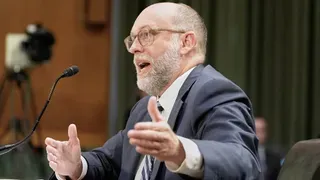July 26, 2015
High Percentage of GLBT Homeless Persists
Kilian Melloy READ TIME: 5 MIN.
San Francisco officials have released a report showing that 29 percent of the city's homeless population identify as LGBT -- the same figure that was reported in 2013, the last time such numbers were released locally.
City leaders and homeless advocates are expressing frustration with the numbers, and are calling for more affordable housing.
"We're not getting anywhere, and even with increased resources finally starting to target the community, we're not gaining any ground," said Brian Basinger, director of the AIDS Housing Alliance/San Francisco. "We should not be seeing flat or increasing rates of homelessness over time. They should be decreasing."
The 2015 Point-in-Time Count includes people without shelter, as well as those staying in homeless shelters, jails, and treatment centers. Counts were conducted January 29. There were a total of 7,539 homeless people, a 2 percent increase from the 7,350 counted in 2013. At 29 percent, there were about 2,186 homeless LGBTs in 2015.
The city's Human Services Agency released the report Thursday, July 16.
After the main count, 1,027 people completed surveys, revealing characteristics that include sexual orientation. The margin of error is plus or minus 3 percentage points.
Basinger called the homelessness problem "one of the social needs that you can actually throw money at and fix. The cure to homelessness is to build affordable housing."
He added, "We need increased investment in a housing infrastructure to keep people in the homes they already have, and to help people move into homes after they lose their housing."
Tommi Avicolli Mecca, who's another gay longtime housing activist and works at the Housing Rights Committee, said the new report is "a wakeup call."
"I wonder if now the community will take [the] challenge and start to do something to alleviate the homelessness and poverty that exists in our community," Avicolli Mecca said. "... We need a huge effort. We need the kind of effort we put into gay marriage."
Avicolli Mecca lauded gay Supervisor David Campos for his efforts to increase affordable housing in the Mission neighborhood, which the District 9 supervisor oversees.
Campos also helped create Jazzie's Place, the 24-bed shelter that opened in June and is designed to be welcoming to LGBT homeless people.
In response to interview requests, including an offer to email questions to the supervisor, Campos aide Carolyn Goossen replied that he would be out of town during the requested times and unable "to do an interview."
Castro Changes
As the report noted, the number of homeless people in District 8, which includes the Castro neighborhood, almost doubled since 2013, going from 95 to 183, according to the report. The figure doesn't include youth.
Greg Hug sits in Jane Warner Plaza in the Castro district. Photo: Seth Hemmelgarn
Greg Hug, 29, who was sitting in the Castro's Jane Warner Plaza last Saturday, said he came to San Francisco last month after staying at a shelter in Contra Costa County.
Hug, who's bisexual and is living with AIDS, is hoping to switch to doctors in the city and get an apartment here. With an income of less than $1,000 a month from Social Security Disability Insurance, finding housing is tough.
He said he's chosen the Castro's 18th street to sleep on instead of staying in another neighborhood because when you "sleep on the sidewalk, you don't have to worry about getting robbed as much."
Gay Supervisor Scott Wiener, whose District 8 includes the Castro area, said he thinks part of the increase of homeless people in the neighborhood is related to development in areas like mid-Market and South of Market.
Many homeless people haven't been able to stay in those neighborhoods, and there's "an uptick" in the homeless population in several places that hadn't traditionally had as many homeless people, Wiener said.
He said the data in the report "reiterates the importance of creating housing for everyone across the entire income spectrum."
The city needs "more supportive housing" and "more affordable housing overall," Wiener said. "We need more support for those in our community who are living on the streets, and we have to continue working hard to move in that direction."
More affordable housing projects could be on the way, he said.
"Overall, we have to accelerate the production of affordable housing," Wiener said. Officials are "looking at other opportunity sites in [District 8] for construction of affordable housing."
Wiener declined to say where those sites are, but he said, "We're actively exploring where we can build affordable housing."
The supervisor is also co-sponsoring recently introduced legislation that would "provide a preference for 25 percent of the units" in affordable housing projects be set aside for residents of the supervisor's district in which the projects are built, he said.
New York City is being sued over a similar policy, Wiener said, and there's "a fine line" legally, but officials have to "make sure people who live in an area where affordable housing is being built have an opportunity to access that housing."
Wiener said he's continuing to work with the nonprofit Larkin Street Youth Services to boost the number of rooms available for young people in the Upper Market neighborhood. In last year's budget, he said, he got funding for efforts that include trying "to connect with youth living on the street, and to try to get them into housing."
He also said, "I was able to obtain quite a bit of funding in the budget this year specifically for homeless and at-risk youth."
Former Supervisor Bevan Dufty, a gay man who is now Mayor Ed Lee's director of Housing Opportunity, Partnerships and Engagement, called the 29 percent figure "staggering."
But Dufty pointed to the city's navigation center, which opened two months after the homeless count was taken, as a sign of progress.
"In our first three months of operation, we are showing success," he said. "We are housing people, and we've created a place that works for people who are long-term homeless individuals on the street," including people who are LGBT.
Dufty said the city's budget includes about $30 million over two years to master lease several single-room occupancy hotels. That will mean about "500 units of housing for guests at the navigation center to move into."
One of the hotels is the Civic Center Hotel, a rundown brick building at 40 12th Street where people regularly lean against the walls outside next to shopping carts.
Many people would likely find sending people to live at the Civic Center unimaginable, but Dufty said, "It has gotten better," with help from the city's Department of Building Inspection.
Lily Madjus, a spokeswoman for the agency, confirmed "conditions have improved" at the building.
The housing situation at the hotel would be temporary. Housing at other hotels would be permanent.
Among other findings, of the survey respondents who said they're LGBT, 34 percent are bisexual, 22 percent are gay, 18 percent are lesbian, 19 percent are transgender, and 9 percent are queer. The other 17 percent "reported an alternative gender identity," according to the city's report.
Additionally, the study says, "Respondents who identified as LGBTQ were more likely to report they were experiencing homelessness for the first time," at 32 percent.
Kilian Melloy serves as EDGE Media Network's Associate Arts Editor and Staff Contributor. His professional memberships include the National Lesbian & Gay Journalists Association, the Boston Online Film Critics Association, The Gay and Lesbian Entertainment Critics Association, and the Boston Theater Critics Association's Elliot Norton Awards Committee.





